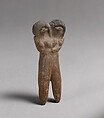Double-headed figure
Some of the earliest known works of art in western South America have been found on Ecuador's Santa Elena Peninsula, where the Valdivia peoples produced small stone and ceramic figurines. These latter statuettes were produced from two slabs of clay pressed together to form the torso and legs. Predominantly female, these figurines often depict women in various stages of their lives. There are examples, however, of figurines with both male and female characteristics, as well as figures, like the one pictured here, which display more than one individual. As seen in the figurine here, two female heads and torsos emerge from a shared lower body. The women's faces are tilted slightly and their expressions are formed by small horizontal incisions. Both figures have short caplike hair and round prominent breasts, appearing from the waist up as mirror images of each other. Their arms are clasped below their chests and their legs are splayed in typical Valdivian figurine stance. Commonly interpreted as fertility figures and/or guardian spirits, the exact purpose of these precocious figurines remains unknown.
This image cannot be enlarged, viewed at full screen, or downloaded.

